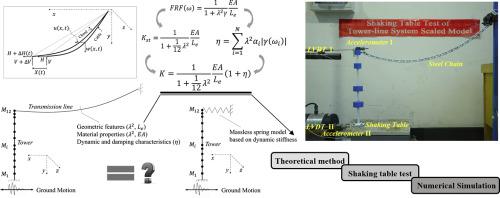当前位置:
X-MOL 学术
›
J. Constr. Steel Res.
›
论文详情
Our official English website, www.x-mol.net, welcomes your
feedback! (Note: you will need to create a separate account there.)
Static and dynamic stiffness in the modeling of inclined suspended cables
Journal of Constructional Steel Research ( IF 4.0 ) Pub Date : 2020-09-01 , DOI: 10.1016/j.jcsr.2020.106210 Jun Gong , Xudong Zhi , Feng Fan , Shizhao Shen
Journal of Constructional Steel Research ( IF 4.0 ) Pub Date : 2020-09-01 , DOI: 10.1016/j.jcsr.2020.106210 Jun Gong , Xudong Zhi , Feng Fan , Shizhao Shen

|
Abstract Inclined suspended cables (ISCs) have several applications in the transmission lines of power network systems. This study attempts to simplify the modeling of ISCs by addressing their static and dynamic stiffness. The dynamic problem of a uniform damping ISC under a harmonic excitation is studied under the assumptions that the suspended cable is deflected in a parabolic profile during static equilibrium and all the displacements in the dynamic in-plane motion are small. A closed expression for the frequency response function (FRF) is derived, based on which the static stiffness of the ISC is established; this aids in modifying the Ernst's formula. Furthermore, the cable dynamic coefficient is defined by considering the participation factors and the minimum number of vibration modes. The dynamic stiffness of the ISC is established by combining the static stiffness and cable dynamic coefficient. In addition, a shaking table test of a reduced-scale tower-line system model is performed to verify the correctness of the finite element model of the suspended cable. The results of the static and dynamic analyses indicate that the spring model based on the dynamic stiffness, showing a good precision, has a higher computational efficiency compared with the suspended cable model. Finally, the spring model, which is applied to the tower-line system by choosing different seismic excitations, inclinations, sag-to-span ratios, and spans of ISCs, is valid for an arbitrary angle of inclination ranging between 0° and 50°. Moreover, its results are in very good agreement with those of the suspended cable model.
中文翻译:

倾斜悬索建模中的静态和动态刚度
摘要 斜悬电缆(ISC)在电力网络系统的传输线中有多种应用。本研究试图通过解决静态和动态刚度来简化 ISC 的建模。假设悬索在静态平衡期间以抛物线形偏转并且动态平面内运动中的所有位移都很小,则研究了谐波激励下均匀阻尼ISC的动力学问题。推导出频率响应函数 (FRF) 的闭合表达式,在此基础上建立 ISC 的静态刚度;这有助于修改恩斯特公式。此外,通过考虑参与因素和最小振动模式数来定义索动力系数。ISC 的动态刚度是通过结合静态刚度和电缆动态系数来建立的。此外,还进行了缩尺塔线系统模型的振动台试验,验证了悬索有限元模型的正确性。静态和动态分析结果表明,与悬索模型相比,基于动态刚度的弹簧模型具有较高的精度,具有更高的计算效率。最后,通过选择不同的地震激发、倾角、垂跨比和 ISC 跨度,将弹簧模型应用于塔线系统,适用于 0° 和 50° 之间的任意倾角. 此外,它的结果与悬索模型的结果非常吻合。
更新日期:2020-09-01
中文翻译:

倾斜悬索建模中的静态和动态刚度
摘要 斜悬电缆(ISC)在电力网络系统的传输线中有多种应用。本研究试图通过解决静态和动态刚度来简化 ISC 的建模。假设悬索在静态平衡期间以抛物线形偏转并且动态平面内运动中的所有位移都很小,则研究了谐波激励下均匀阻尼ISC的动力学问题。推导出频率响应函数 (FRF) 的闭合表达式,在此基础上建立 ISC 的静态刚度;这有助于修改恩斯特公式。此外,通过考虑参与因素和最小振动模式数来定义索动力系数。ISC 的动态刚度是通过结合静态刚度和电缆动态系数来建立的。此外,还进行了缩尺塔线系统模型的振动台试验,验证了悬索有限元模型的正确性。静态和动态分析结果表明,与悬索模型相比,基于动态刚度的弹簧模型具有较高的精度,具有更高的计算效率。最后,通过选择不同的地震激发、倾角、垂跨比和 ISC 跨度,将弹簧模型应用于塔线系统,适用于 0° 和 50° 之间的任意倾角. 此外,它的结果与悬索模型的结果非常吻合。











































 京公网安备 11010802027423号
京公网安备 11010802027423号